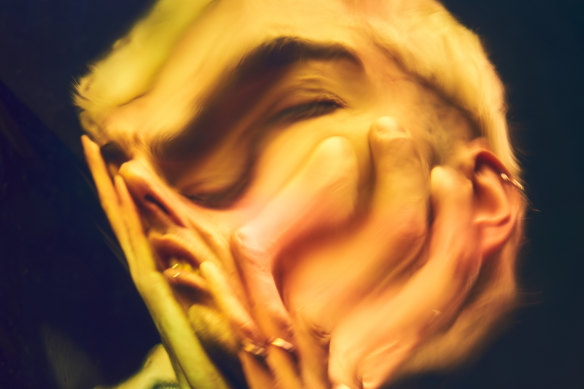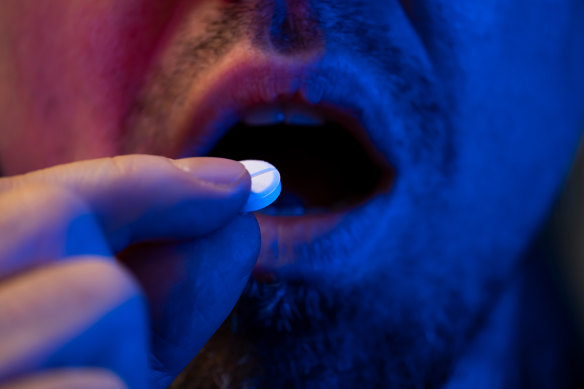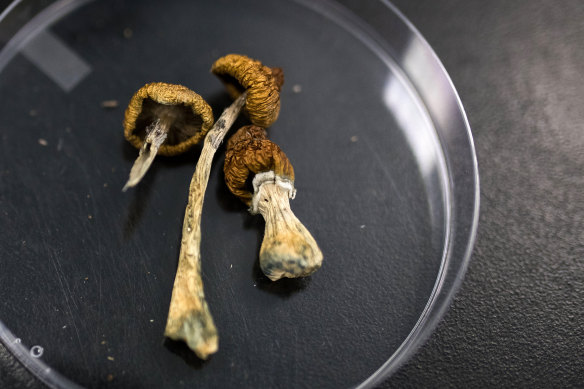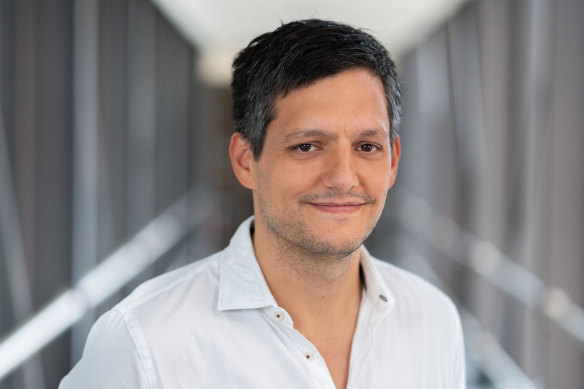When Ollie took a pill, he didn’t realise it would be a ‘never-ending trip’
From medical trials to magic mushrooms, psychedelics are back in the spotlight. But for a small but significant number of users, the side effects never cease.
By Tim Elliott

Australians may be exposing themselves to the risk of HPPD without knowing it: “What we need is greater awareness of the condition,” says psychiatrist and professor Harry McConnell.Credit: Studio Marmellata / Stocksy Unit
The walls began moving about an hour after Ollie* took the pill. Nothing dramatic, just a gentle pulsing, like a sheet in a breeze. The colours were a bit strange, too. The fluorescent yellow traffic sign on his bedroom wall had turned pink, and the lava lamp in the corner of the room seemed unusually bright. “I realised something was happening that wasn’t what I was expecting,” he tells me. “I thought, ‘This isn’t what I signed up for.’ ”
It was 1999, and Ollie, 16, was living downstairs at his parents’ house on Sydney’s north shore. Tall and lean, with pale skin and dark, shoulder-length hair, he was cerebral and aloof, and good at guitar (the girls compared him to the singer Jeff Buckley). A precocious intellect had earned him entry into the local selective high school. He was, he says now, “a bit nerdy”, but with an alternative bent. He listened to Radiohead and rave music, was interested in Karl Marx and political economy, and had just read Franz Kafka’s The Metamorphosis, a surreal allegory about a man who wakes up one morning to find himself transformed into a gigantic insect.
Now, it seemed, he was undergoing something equally strange. The pill, which Ollie had bought from an older boy at school, was meant to be MDMA, the party drug also known as ecstasy. Ollie had smoked pot before but had never taken pills. He knew, however, that MDMA wasn’t meant to be psychedelic. Now, his room seemed to be expanding and contracting, and strange movements appeared in his peripheral vision. “I wasn’t scared,” he says. “I was in a good place, so I just rolled with it.” For the next eight or so hours, he stayed in his room, lying on his bed, listening to music on his headphones. He finally fell asleep at about 4am.
He woke up the next morning feeling tired but otherwise fine, and went to school as normal. He was nearing the end of year 10, and was gearing up for his final two years. But about a week after taking the pill he walked into first period, sat down and was consumed by a sense of catastrophic dread. “It hit me like a ton of bricks,” he says. He fled the classroom and got the bus home. On the way, his vision became grainy, like static on an old TV. Passing cars left trails behind them, like comets in the night. Worse, he began to feel as if he were outside his body, decoupled from his sense of self. “It was a nightmare,” he says. “I thought, ‘Oh my god, I’ve broken my brain.’ ”
One person describes it as a ‘living hell’. Another says, ‘It cooked my life.’
Ollie fessed up to his parents, who suggested he wait a few days for the effects to wear off. But they didn’t. When he walked, he felt as if he were floating, “like on one of those moving walkways at the airport”. His depth perception went haywire, and he felt increasingly disconnected from reality. His GP gave him antidepressants but they only made things worse, so he stopped taking them. His parents then took him to the top neurologist at Royal North Shore Hospital, but, according to Ollie, “the guy clearly had no idea”. He also had a psychiatric assessment. “They determined that I wasn’t delusional or psychotic and that I wasn’t bipolar or schizophrenic,” he tells me. “They diagnosed me as having general anxiety disorder and wrote me a script for antidepressants, but I didn’t use them.”
Ollie had been a gifted student with plenty of friends, but he now spent weeks in his room. “The end of year 10 was horrible,” he says. He started kinesiology, which made him feel more grounded, and went back to school the following year. But reading was almost impossible, and his dissociation became unbearable. Halfway through year 12, with the support of his parents and school counsellor, he dropped out. “I caught a train to Byron Bay and got a job in bush regeneration,” he says. “Being out in nature really helped.”
The next five years were a rollercoaster. He developed insomnia and depression. He adapted somewhat to his visuals, and his anxiety abated. In 2006, he went backpacking through Central America. He was sitting on the computer at his hostel in Guatemala one day when he came across an article about an obscure condition known as hallucinogen persisting perception disorder (HPPD). “Everything just snapped into place,” he says. “I knew that was what I had.” Until then, Ollie had thought he was the only one, “a total freak”, but now he saw that there were whole HPPD forums and that thousands of people had the same condition. “I thought, ‘I’m not alone.’ ”
HPPD is often described in the research literature as an “adverse event” caused by psychedelic drugs. But HPPD is adverse in the way that a car crash is adverse. The condition, which is mainly associated with LSD and psilocybin (aka “magic mushrooms”) but also MDMA, ketamine and even marijuana, is characterised by ongoing hallucinations and visual distortions. Most acid trips last between six and 12 hours. But people with HPPD continue to experience the effects long after that, seeing halos, starbursts or geometric patterns. Objects vibrate, walls breathe; the world becomes seen through a scrim of tiny dots, like drifting snow.

People who have HPPD are in absolute mental anguish, says one Australian researcher. “Since I started working, I’ve had people ring me up saying they are suicidal and is there anything I can do for them.”Credit: Getty Images
People with HPPD can become trapped, like Alice, in their own terrifying, real-life Wonderlands; objects can appear larger or smaller, or closer or further away, than they really are. One man I speak to says he keeps seeing faces in wooden surfaces and clouds. And it’s not just visual effects. HPPD can cause tinnitus, vertigo and the twin dissociative disorders known as depersonalisation and derealisation, a sense that you and/or the world aren’t real, and that, as one sufferer tells me, “you’re living in some kind of video game”. The symptoms can linger for a few days or several years, and in some cases, for life. Thus, the condition is often referred to as “the trip that never ends”. There are treatments but no cure. One person describes it to me as “a living hell”. Another says, “It cooked my life.”
“It’s pretty intense,” says Professor Paul Sowman, from the KIT-Macquarie Brain Research Laboratory at Macquarie University, who has been looking into HPPD since 2018. “People who have it are in absolute mental anguish. Since I started working, I’ve had people ring me up saying they are suicidal and is there anything I can do for them.”
Visual changes like those in HPPD were first documented in 1954 during research into the clinical application of LSD. In 1969, they came to be known as “flashbacks”, a term that soon became part of counterculture folklore, popularised by people who claimed, for example, to have been in aisle three of Woolworths shopping for vegetables when they suddenly found themselves back at Woodstock, tripping on “the brown acid” again and talking to Jesus. Such experiences could be pleasant or unpleasant, but they were usually transient.
In 1971, however, a young resident psychiatrist at the Massachusetts General Hospital, Henry Abraham, began noticing a different, more worrying phenomenon. “I was working in the emergency room at night and I began seeing one kid after another coming in describing a range of visual disturbances which they said they had more or less permanently,” says Abraham, who is now retired and living in Michigan. “They knew the hallucinations weren’t real, but they couldn’t get rid of them.”
Abraham, who is 81, has a bald head, large, owlish glasses and an empathetic manner. “These weren’t bad kids. Lots of them were just adventurers of the mind. They wanted to know something about themselves, or expand their consciousness, and they ended up damaging themselves very badly.” Still, no one seemed particularly interested in them. “So I began keeping tabs and getting them to draw pictures of what they were seeing, and embarking on scientific investigations to pin down the condition.” Thanks largely to Abraham’s work, HPPD was recognised as a clinical condition in 1987, when it was listed initially as “post-hallucinogen perception disorder” in the revised third edition of the Diagnostic and Statistical Manual (DSM), an encyclopaedia of psychiatric disorders used by clinicians worldwide. (Its name changed to Hallucinogen Persisting Perception Disorder in DSM-IV-R, in 1994.)
HPPD is thought to affect 4-4.5 per cent of people who take psychedelic drugs, but this may be an underestimate, as some sufferers don’t report their symptoms for fear of legal repercussions or are misdiagnosed with other conditions. There are online HPPD forums on Reddit and Facebook in which tens of thousands of sufferers commiserate, swap harrowing stories and provide support. Search for HPPD on TikTok and YouTube, and you’ll find scores of videos that have been watched millions of times.
Despite this, little progress has been made with HPPD since it was first recognised. Some doctors still haven’t heard of it. (“Tell me again what that is,” a senior specialist in alternative medicines says when I ask her about it.) Abraham tells me that sufferers can see up to six specialists – psychiatrists, optometrists, neurologists – before receiving a diagnosis. “I remember sitting in one doctor’s office and having him basically tell me I was making it up,” Ollie says. “I felt like pointing to the DSM, which was on his bookshelf, and saying, ‘But it’s in there!’ ”
Many people with HPPD become depressed. It’s not known whether depression is part of the condition, or if they become depressed because they have the condition. Either way, when they consult a psychiatrist they are in many cases prescribed SSRIs, a popular strain of antidepressants, despite the fact that SSRIs have been known to exacerbate HPPD symptoms.
“HPPD is not a mood disorder,” says Queensland psychiatrist Professor Harry McConnell. “It’s a perceptual disorder with a neurological basis. We think that it has to do with the parts of the brain – probably the thalamus and some other areas – that both filter and amplify visual perception. Psychedelics seem to permanently disrupt these mechanisms so that we get overwhelmed with visual stimuli.”
McConnell, 67, speaks with a heavy American accent (he was born in Pennsylvania) and in a breathless upper register, as if he’s just run out of a burning building. Together with his daughter Dr Anneliese McConnell, a researcher at the Western Sydney University School of Medicine, Paul Sowman and Dr Wei He from Macquarie University, he has just concluded a non-peer-reviewed study which suggests that HPPD may be associated with other disorders such as migraines or tinnitus, indicating the condition may not be just a disorder of visual perception. In terms of a definition, then, HPPD is a work in progress. One thing he does know for sure is that it’s not dose-related. “You can get it on your first trip or on your one-hundred-and-first trip,” he says. “I’ve seen someone get HPPD from a single microdose.”

HPPD is mainly associated with LSD and psilocybin (aka “magic mushrooms”) but also MDMA, ketamine and marijuana.Credit: Getty Images
There are also cases of people getting the condition after taking part in research. I speak with Joy*, a Canadian woman who was left with HPPD in 2022, after taking part in a clinical trial to test the efficacy of psilocybin in treating depression. In 2017, the Journal of Alcoholism and Drug Dependence reported the case of a 15-year-old boy in the US who developed HPPD after receiving ketamine for chronic pain. Publicity around the potential of psychedelics to treat all manner of mental health disorders has also led to a wave of freelance therapists who are intent on treating themselves or others. “I’d been on and off antidepressants for 20 years, and I was searching for alternatives,” says Peter*, a 43-year-old man who lives in Canberra, who got HPPD in 2018 after experimenting with magic mushrooms. “I still have panic attacks, and my cognition is off. Sometimes I have trouble following the plot of movies.”
Psychedelics are becoming increasingly popular in Australia: according to the National Drug Strategy Household Survey 2022-2023, more than 500,000 people had used them in the previous 12 months. Another 400,000 had used MDMA. McConnell is now worried that more Australians are exposing themselves to the risk of HPPD without knowing it. “What we need is greater awareness of the condition,” he says. “We need more funding to find out who is at risk and how we can prevent it.” But that’s not happening. Indeed, it seems to be the exact opposite.
Traditional cultures have for thousands of years used psychedelic drugs, including mushrooms, mescaline and ayahuasca, for religious and spiritual purposes, as well as medicine and magic. But the modern history of psychedelics began in 1943 with Albert Hofmann, a Swiss chemist who was researching lysergic acid diethylamide, or LSD, a chemical that he had isolated from a grain fungus, when he possibly got some on his fingers. He began to feel dizzy and went home where, as he wrote later, “[I] sank into a not unpleasant intoxicated-like condition, characterised by an extremely stimulated imagination.”
Hofmann came to regard LSD as “a sacred drug”; a tool for investigating human consciousness. In the 1950s and 1960s, LSD was considered the next big thing in psychiatry and was used in the US and the UK to treat alcoholism, schizophrenia and depression. (It was also prescribed to children with autism.) The drug also became popular with the counterculture, whose misadventures with LSD, often inspired by Harvard researcher and rogue psychonaut Dr Timothy Leary, occasioned a full-blown moral panic. In 1968, the US banned LSD; most Western countries followed suit. For psychiatrists and researchers, the promise of LSD and other psychedelics had been squandered.
Research was suppressed for decades, until 1990, when the University of New Mexico School of Medicine began testing the effects of DMT, a hallucinogen closely related to psilocybin, on 60 people. The trial, which was conducted by Rick Strassman, an associate professor of psychiatry, showed that you could give DMT safely to humans.
With the support of privately funded organisations such as the Multidisciplinary Association for Psychedelics Studies (MAPS) in the US, and the Beckley Foundation in the UK, more studies were rolled out in the 2000s. According to psychedelics advocacy group Mind Medicine Australia, which was founded in 2018, there have now been more than 300 such trials worldwide.
“They have had very positive results,” Peter Hunt, the MMA chairman, tells me. “The remission rates for depression are significantly higher with medical psilocybin and MDMA than with current treatments.”

Mind Medicine Australia head Peter Hunt and his wife, Tania de Jong.
A former investment banker, Hunt was turned on to psychedelic medicines after undergoing a guided psilocybin therapy session in the Netherlands in 2016 with his wife, the opera singer Tania de Jong. “I’d never been previously drawn to psychedelics,” he tells me in an email. “I’m not sure I even knew what psychedelics were, but Tania had read the research and was intrigued by the possibilities and I trusted her judgment.” He now describes the experience as “out of this world” and “a miracle”.
In his style (evangelistic) and background (wealthy, curious), Hunt is an exemplar of what has become known as the “psychedelic renaissance”, a resurgence of interest among clinicians and researchers that frames psychedelics as a paradigm shift in mental health therapies, a supercharged modality capable, by some accounts, of curing the ill in just one or two sessions. Under the auspices of advocates and entrepreneurs, psychedelics have come to occupy a space both scientific and shamanistic, where modern chemistry commingles with metaphysics – begetting, in the process, truly cosmic quantities of money. According to the financial information outfit Research and Markets, it is estimated that the psychedelics industry worldwide will be worth $US10.75 billion by 2027.
With so much at stake, terms such as HPPD and “adverse events” are unwelcome, to say the least. “Psychedelics proponents are worried that the existence of something like HPPD might bring the whole development and medicalising and legalising of psychedelics to a halt again,” says Dr Tomislav Majic, a senior physician at the Charité Psychiatric University Clinic in St Hedwig Hospital, Berlin, who conducts clinical trials with psychedelics as well as dealing with psychedelic-related harms. “That is why the mere existence of HPPD is often challenged.”

“Psychedelics proponents are worried that the existence of something like HPPD might bring the whole development and medicalising and legalising of psychedelics to a halt again,” says Dr Tomislav Majic.
Many senior researchers and psychedelic proponents continue to deny any link between hallucinogens and HPPD. Some claim there have been no cases of HPPD resulting from clinical trials, and continue to minimise adverse events. “No one has ever come out of a [psychedelics] trial feeling more depressed,” Professor David Nutt, the head of neuropsychopharmacology at Imperial College London and a vocal proponent of psychedelic treatments, told the ABC in March. Nutt, who was instrumental in the decision by the Therapeutic Goods Administration in July 2023 to legalise psychedelics therapy in Australia, says adverse effects from such therapy might be due to a lack of follow-up. Sydney psychiatrist Ted Cassidy, who has been administering psychedelics to patients since January, agrees: “These drugs have been shown to be very safe. We have never seen any side effects.”
“The problem is that adverse events like HPPD are often poorly defined and probably underreported,” says Ed Prideaux, who did a master’s on HPPD at the University of East London, and has been a researcher at the Perception Restoration Foundation, a non-profit that raises awareness about the condition. (Prideaux also has HPPD, which he developed after taking 1-P LSD, an analogue of LSD, eight years ago. He still experiences visual distortions, but they have abated markedly over time.)
In 2023, French researchers conducted a systematic review of clinical trials of esketamine, a type of ketamine, for depression, and found that 41.5 per cent of serious adverse events didn’t appear in the final publications. Joy*, who developed HPPD after taking part in a clinical trial with psilocybin in Toronto in 2022, was dismayed to find the final research paper made no mention of her experience, which included acute depersonalisation and derealisation.
One reason HPPD is talked about so little is that it is most commonly seen in recreational drug users, who, generally speaking, don’t get much sympathy. But the tut-tutting seems hypocritical. Who hasn’t in their youth been reckless, drunk too much, smoked some pot or made a mistake? “People don’t have much compassion until it happens to them,” says Ollie.
Online HPPD forums often recommend benzodiazepines such as clonazepam, which seem to tamp down the response to visual stimuli and help with anxiety. Ollie tried benzodiazepines but soon dropped them, concerned that they are addictive. These days, he’s not on any medication. “I just take supplements, like fish oil and magnesium, stuff that’s good for cognition. And I do lots of exercise, walking and stuff that involves new movement patterns.”
He still experiences low-level derealisation, more or less constantly, along with visual disturbances and insomnia. While his stress has never gone away, it’s now at a tolerable level. But his life changed irrevocably the night he took that pill. “I’ve been in and out of jobs, I’m broke, and I live with my parents, which isn’t exactly how I saw my life panning out.”
When he was in primary school, he took part in an accelerated learning program with a young girl. They were the only two kids in their area to take part. “We were taken out of sixth class and put in year 7 for one day a week.
The girl who did it with me went on to an Ivy League university, and has worked for the Australian and US governments.” He winces. “That’s what gets me. I’ll never know what I could have become if this hadn’t happened. I’ll never know what could have been.”
* Names have been changed.
To read more from Good Weekend magazine, visit our page at The Sydney Morning Herald, The Age and Brisbane Times.